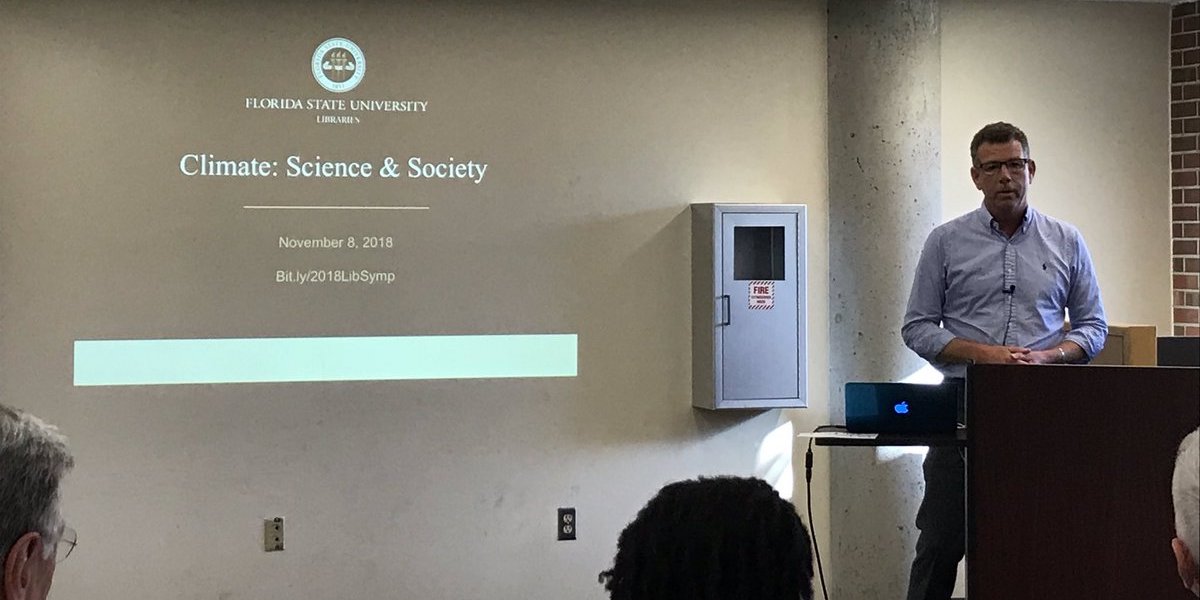The Florida Climate Center serves as the primary resource for climate data, information, and services in the state of Florida.
What's new in our world?
The Florida Climate Center achieves its mission by providing climate monitoring, research, and expertise to be applied by the people, institutions, and businesses of Florida and the surrounding region.
We provide direct service by fulfilling requests for climate and weather data and information in a variety of formats.
We perform research that advances the understanding of the climate variability and changes of Florida and the surrounding region.
We provide outreach in presentations and at events aimed at a variety of groups, interests, and ages.
Prepared by Florida Climate Center
The Florida State University
Tallahassee, FL
June Key Points:
- Average temperatures were near normal during the month.
- Rainfall totals in June were mixed, with some places receiving well above normal rainfall and other places slightly below normal.
- Abnormally dry conditions (D0) persist in some places in South Florida, but moderate drought has dissipated with the onset of the wet season.
- Tropical Storm Claudette impacted the western Florida Panhandle, leading to high surf and localized flooding.
Average temperatures in June were near normal across the state. Average temperature departures ranged from -1.3F in Key West to +0.9F in Tampa for the month (see Table 1 and Appendix 1 for select cities). There were only a few daily high maximum temperature records set, but many daily high minimum records were set during the month (see Appendix 2).
Table 1. June average temperatures and departures from normal ( ̊F) for selected cities.
| Station | Mean Temperature | Departure from Normal |
| Pensacola | 81.3 | -0.4 |
| Tallahassee | 80.8 | 0 |
| Jacksonville | 79.1 | -1.2 |
| Orlando | 81.9 | +0.7 |
| Tampa | 83.8 | +0.9 |
| Miami | 82.7 | -0.1 |
| Key West | 82.8 | -1.3 |
Rainfall departures from normal in June were mixed, with many areas well above normal and other areas slightly below normal. Rainfall across the state increased in June compared to the previous month with the onset of the wet season, which provided drought relief to some parts of south Florida though much of the southern Peninsula still had below normal rainfall (Figure 1). Monthly departures from normal ranged from +5.23 inches in Tampa to -1.93 inches in Miami (Table 2 and Appendix 1). The Panhandle was particularly wet during the middle to latter part of the month as Tropical Storm Claudette impacted the western Panhandle on the 19th, which was followed by a slow-moving cold front that produced heavy rainfall and thunderstorms and led to flash flooding in the area. Pensacola set a new one-day rainfall record for the 19th with 3.99 inches due to Tropical Storm Claudette. Several additional daily rainfall records were set during the month of June.
Table 2. June precipitation totals and departures from normal (inches) for selected cities.
| Station | Total Rainfall | Departure from Normal |
| Pensacola | 12.26 | +4.94 |
| Tallahassee | 5.84 | -1.92 |
| Jacksonville | 9.71 | +2.11 |
| Orlando | 7.06 | -0.99 |
| Tampa | 12.60 | +5.23 |
| Miami | 12.44 | +1.93 |
| Key West | 2.58 | -1.65 |
Figure 1. A graphical depiction of the monthly rainfall departure from normal (inches) for June (courtesy of NOAA, NWS).

ENSO-Neutral Conditions.
ENSO-neutral conditions currently exist and are likely to remain through the summer (78% chance for June-August). There is more uncertainty in the models after summer based on the latest IRI/CPC models. There is a 51% chance that neutral conditions will persist in the fall (August - October) and a slightly greater chance for La Niña conditions to potentially redevelop during fall and last through the winter season (66% chance during November-January).
Hazardous Weather Events in June.
According to the Local Storm Reports issued by the local National Weather Service offices serving Florida, there were 447 individual local reports of hazardous weather events recorded across the state during the month of June (see Table 4 for a breakdown by event type). Thunderstorm activity throughout the month resulted in flash flooding and peak wind gusts exceeding 40 mph in several instances. Straight-line winds impacted Brevard County on the 13th when winds were estimated to be between 65-70 mph, which resulted in significant damage to a couple of homes that had their roofs uplifted. Tropical Storm Claudette impacted the western Florida Panhandle on the 19th, with gusts peaking at 81 mph and high surf of 6-12 feet flooded local beaches and roadways. No injuries or fatalities were reported in Florida, though at least 14 people died in Alabama due to the storm.
Table 4. Breakdown of storm reports submitted in Florida during the month of June (compiled from Iowa State University/Iowa Environmental Mesonet).
| Report Type | Number of Reports |
| Flood | 19 |
| Coastal Flood | 2 |
| Flash Flood | 7 |
| Hail | 34 |
| Heavy Rain | 38 |
| Marine Thunderstorm Wind | 77 |
| Non-Thunderstorm Wind Gust | 2 |
| Tornado/Waterspout/Funnel Cloud | 0/13/3 |
| Thunderstorm Wind Damage | 76 |
| Thunderstorm Wind Gust | 165 |
| Lightning | 3 |
| Rip Currents | 5 |
| Wildfire | 3 |
Drought-Related Impacts.
From early to mid-June, moderate drought (D1) existed across much of the southern Peninsula, and both northern and southern Florida were experiencing abnormally dry conditions. As of June 29, abnormally dry conditions existed across parts of the southern Florida Peninsula and any areas that were in moderate drought earlier in the month have dissipated. According to the U.S. Drought Monitor, about 11% of the state was experiencing abnormally dry conditions (D0) by the end of the month, down from 26% the week before.
As of June 30, the Lake Okeechobee water level was at 12.77 ft. above sea level (Feet-NGVD29), which is just below the average for this time of the year. At the first of the month, the water level was 12.79 ft. above sea level.
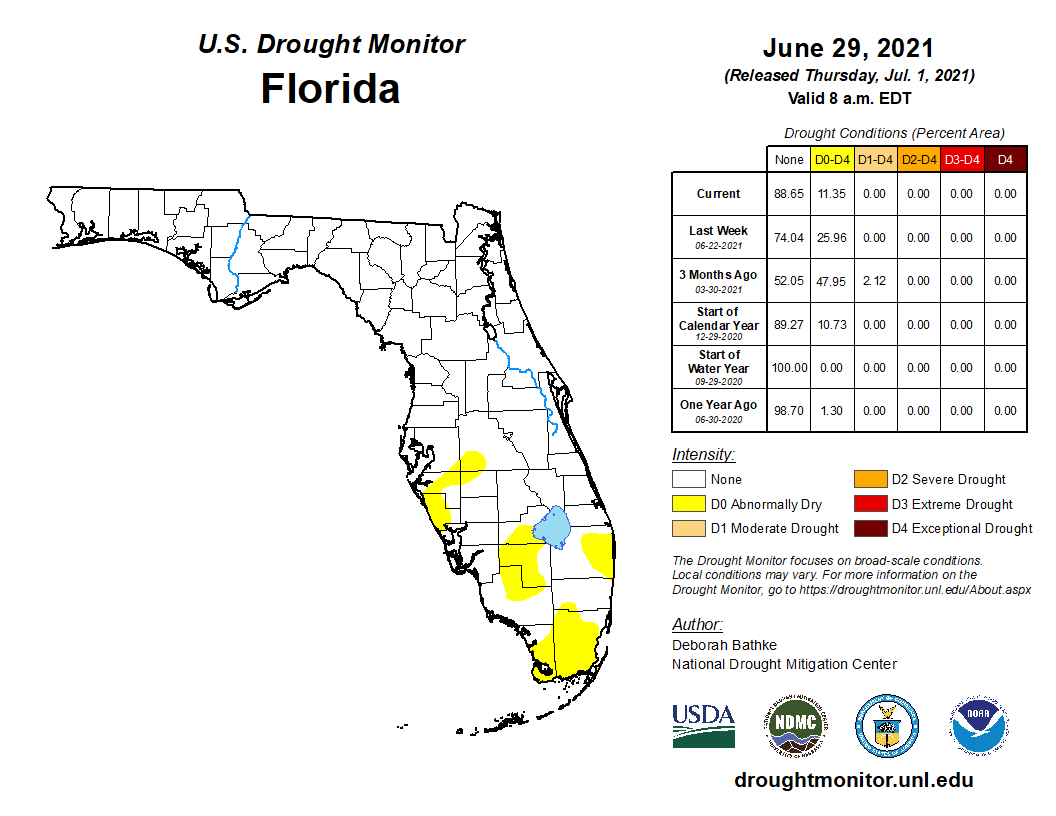
Agriculture-Related Impacts.
During mid-June, topsoil moisture levels were adequate for 60% of the state, short in 32%, and very short in 8%, while no part of the state was in surplus. By the end of June, topsoil moisture levels were adequate in 73% of the state, short in 10%, and very short in just 1% of the state; 16% of the state was in surplus. Much of the state had either fair (29%), good (53%) or excellent (10%) pasture and range conditions by the end of the month. For more information, consult the weekly Crop Progress and Conditions report published by the USDA's National Agricultural Statistics Service.
Appendix 1
Additional June departures from normal data for select Florida locations (Source: NWS).
| Station | Average Temperature (˚F) | Departure from Normal (˚F) | Total Rainfall (in.) | Departure from Normal (in.) |
| Gainesville | 79.8 | -0.1 | 11.38 | +3.82 |
| Sarasota | 82.6 | +0.8 | 9.20 | +2.15 |
| Melbourne | 81.4 | -0.5 | 6.61 | -0.49 |
| Fort Myers | 83.0 | +0.7 | 11.58 | +1.92 |
| West Palm Beach | 82.7 | +1.0 | 6.85 | -1.63 |
Appendix 2
Select daily record high minimum temperatures tied or broken during June (compiled from NOAA).
| Location | Date | Record (˚F) | Broken/Tied | Last |
| Orlando | 5 | 75 | Tied | 75 in 2019 |
| Vero Beach | 7 | 78 | Broken | 77 in 2016 |
| Daytona Beach | 7 | 78 | Broken | 77 in 1950 |
| Orlando | 7 | 78 | Broken | 77 in 1903 |
| Lakeland | 7 | 77 | Broken | 75 in 1982 |
| Daytona Beach | 8 | 79 | Broken | 78 in 2013 |
| Jacksonville Beach | 8 | 80 | Broken | 76 in 2011 |
| West Palm Beach | 8 | 80 | Tied | 80 in 2020 |
| Clermont | 9 | 77 | Broken | 76 in 2020 |
| Miami | 10 | 80 | Tied | 80 in 2020 |
| Fort Myers | 12 | 78 | Broken | 77 in 2009 |
| Bradenton | 13 | 78 | Broken | 77 in 2016 |
| Clermont | 13 | 76 | Broken | 75 in 2020 |
| Plant City | 13 | 77 | Broken | 76 in 2016 |
| Venice | 13 | 80 | Broken | 79 in 1997 |
| Fort Myers | 13 | 79 | Broken | 78 in 1998 |
| Jacksonville Beach | 18 | 78 | Broken | 77 in 2019 |
| Perrine | 19 | 79 | Broken | 76 in 1993 |
| Plant City | 19 | 77 | Broken | 76 in 1990 |
| Vero Beach | 19 | 78 | Broken | 76 in 2017 |
| West Palm Beach | 19 | 81 | Broken | 78 in 2017 |
| Lakeland | 19 | 78 | Broken | 76 in 1969 |
| Bradenton | 20 | 80 | Broken | 78 in 2019 |
| Plant City | 20 | 79 | Broken | 75 in 2019 |
| Sanford | 20 | 78 | Broken | 76 in 2013 |
| Key West | 20 | 83 | Tied | 83 in 2020 |
| Tampa | 20 | 82 | Broken | 80 in 2018 |
| Orlando | 20 | 79 | Broken | 77 in 2009 |
| Sanford | 21 | 79 | Broken | 75 in 2017 |
| Mayport | 26 | 78 | Broken | 76 in 2020 |
| Vero Beach | 27 | 77 | Broken | 76 in 2017 |
| Lakeland | 29 | 77 | Broken | 76 in 1978 |
Prepared by Florida Climate Center
The Florida State University
Tallahassee, FL
July Key Points:
- Average temperatures were mixed but near normal for the month.
- Rainfall totals in July were mixed, but most places received above-normal rainfall.
- Drought is not currently impacting the state.
- Abnormally dry conditions (D0) persist in some places in South Florida, but moderate drought has dissipated with the onset of the wet season.
- Hurricane Elsa impacted Florida July 5-7; it was the first hurricane of the 2021 season and became the earliest forming fifth named storm on record in the Atlantic Basin
Average temperature departures in July were mixed but temperatures were near normal across the state. Average temperature departures ranged from -1.4 ̊F in Key West to +0.8 ̊F in Fort Myers for the month (see Table 1 and Appendix 1 for select cities). There were some daily high maximum temperature records set during July, but many more daily high minimum temperature records were set during the month (see Appendix 2).
Table 1. July average temperatures and departures from normal ( ̊F) for selected cities.
| Station | Mean Temperature | Departure from Normal |
| Pensacola | 83.3 | -0.2 |
| Tallahassee | 82.1 | -0.4 |
| Jacksonville | 81.1 | -1.4 |
| Orlando | 83.3 | +0.7 |
| Tampa | 85.0 | +1.2 |
| Miami | 83.7 | -0.4 |
| Key West | 84.0 | -1.4 |
Rainfall totals in July varied, with many areas receiving well above normal rainfall but some areas were below normal. Much of Florida received above normal rainfall, including the western Panhandle, northern and central Florida, and south-central parts of the state (Figure 1). Hurricane Elsa impacted many parts of the state from July 5-7, which brought heavy rain particularly across north central Florida as it made landfall in Taylor County. Monthly departures from normal ranged from +4.02 inches in Key West to -2.61 inches in Tallahassee (Table 2 and Figure 1). Several daily rainfall records were set during the month of June; the highest recorded daily rainfall during the month occurred on the 6th with 9.01 inches of rain at Mountain Lake.
Table 2. July precipitation totals and departures from normal (inches) for selected cities.
| Station | Total Rainfall | Departure from Normal |
| Pensacola | 8.78 | +0.89 |
| Tallahassee | 4.53 | -2.61 |
| Jacksonville | 8.87 | +2.10 |
| Orlando | 6.44 | -1.02 |
| Tampa | 7.30 | -0.45 |
| Miami | 8.18 | +0.82 |
| Key West | 7.65 | +4.02 |
Figure 1. A graphical depiction of the monthly rainfall departure from normal (inches) for July (courtesy of NOAA, NWS).
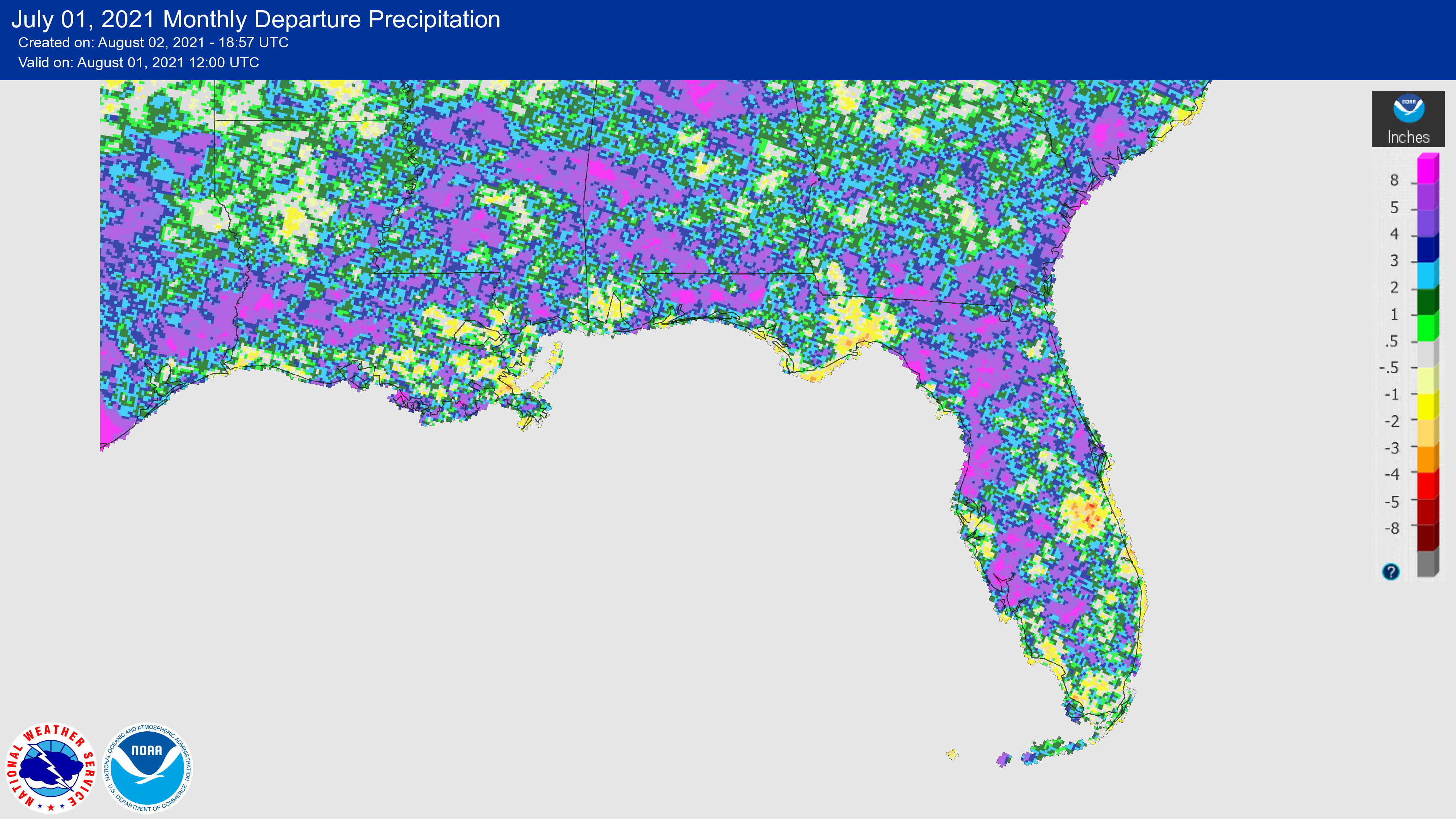
ENSO-Neutral Conditions.
ENSO-neutral conditions currently exist and are likely to remain through the summer and early fall (51% chance August-October). There is a higher chance that La Niña conditions will redevelop during the fall (September-November) and last through the winter season (~70% chance during November-January).
Hazardous Weather Events in July.
According to the Local Storm Reports issued by the local National Weather Service offices serving Florida, there were 433 individual local reports of hazardous weather events recorded across the state during the month of July (see Table 4 for a breakdown by event type). Hurricane Elsa impacted parts of south, central and northern areas of the state from July 5-7 with heavy rainfall, localized flooding, riverine flooding in north and central Florida, and storm surge. There was one fatality reported in Jacksonville due to a fallen tree. Elsa made landfall in Cuba as a tropical storm and then briefly regained hurricane status over the Gulf of Mexico before making another landfall as a tropical storm in the eastern Florida Panhandle in Taylor County.
Table 4. Breakdown of storm reports submitted in Florida during the month of July (compiled from Iowa State University/Iowa Environmental Mesonet).
| Report Type | Number of Reports |
| Flood | 21 |
| Flash Flood | 4 |
| Hail | 9 |
| Heavy Rain | 36 |
| Marine Thunderstorm Wind | 68 |
| Non-Thunderstorm Wind Gust | 0 |
| Tornado/Waterspout/Funnel Cloud | 3/16/1 |
| Thunderstorm Wind Damage | 24 |
| Thunderstorm Wind Gust | 105 |
| Lightning | 6 |
| Rip Currents | 1 |
| Storm Surge | 2 |
| Tropical Storm | 137 |
Drought-Related Impacts.
As of the end of July, drought was not impacting any part of the state. From early to mid-July, a small pocket of abnormally dry conditions persisted in the southern tip of the Peninsula, but by end of July this had dissipated. According to the U.S. Drought Monitor, just 1.13% of the southern part of the state was experiencing abnormally dry conditions (D0) but with continued rainfall during the wet season this has been alleviated.
As of July 31, the Lake Okeechobee water level was at 13.70 ft. above sea level (Feet-NGVD29), which is right around the average for this time of the year. At the first of the month, the water level was 12.82 ft. above sea level.
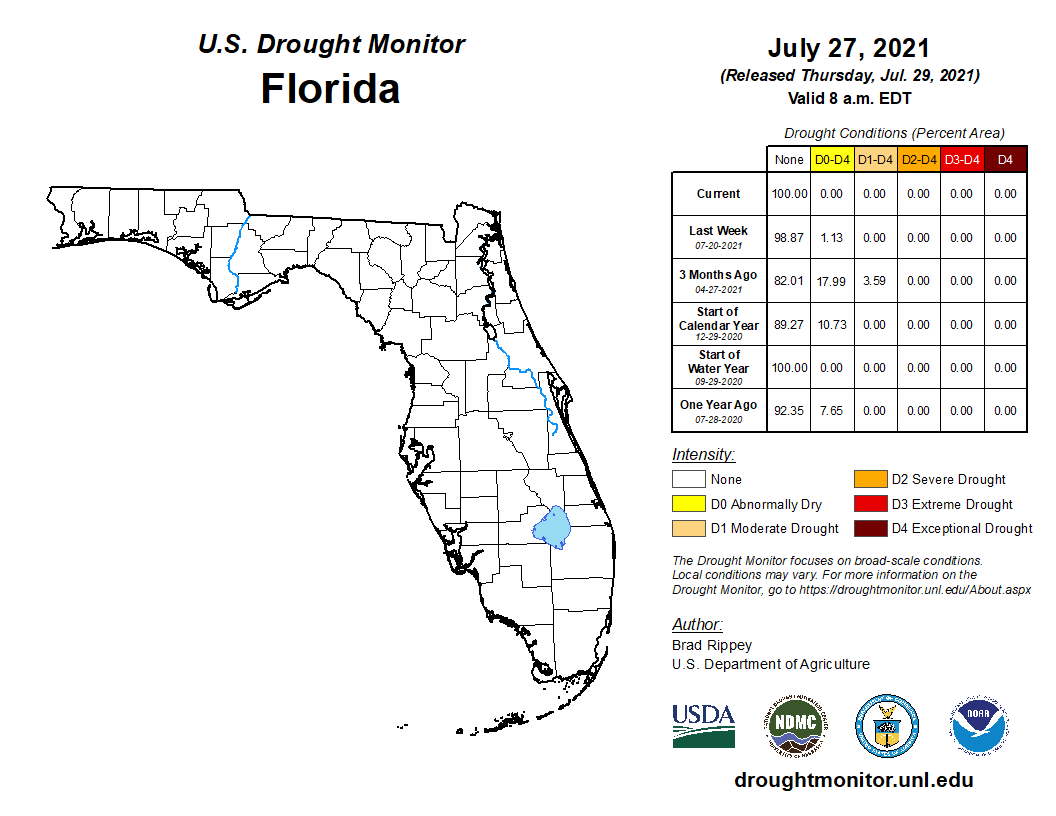
Agriculture-Related Impacts.
In mid-July, topsoil moisture levels were adequate for 67% of the state, short in 4%, and 29% of the state was in surplus. By the end of July, topsoil moisture levels were adequate in 80% of the state, short in 7%, and 13% of the state was in surplus. Much of the state had either good (51%) or excellent (35%) pasture and range conditions by the end of the month. For more information, consult the weekly Crop Progress and Conditions report published by the USDA's National Agricultural Statistics Service.
Appendix 1
Additional July departures from normal data for select Florida locations (Source: NWS).
| Station | Average Temperature (˚F) | Departure from Normal (˚F) | Total Rainfall (in.) | Departure from Normal (in.) |
| Gainesville | 81.0 | -0.4 | 13.99 | +7.31 |
| Sarasota | 82.9 | -0.2 | 10.38 | +2.99 |
| Melbourne | 82.9 | -0.2 | 5.13 | -1.37 |
| Fort Myers | 84.0 | +0.8 | 8.86 | -0.52 |
| West Palm Beach | 83.3 | +0.2 | 5.66 | +0.03 |
Appendix 2
Select daily record high minimum temperatures tied or broken during July (compiled from NOAA).
| Location | Date | Record (˚F) | Broken/Tied | Last |
| Melbourne | 7 | 79 | Broken | 78 in 2010 |
| Perrine | 7 | 78 | Broken | 76 in 2017 |
| Stuart | 7 | 80 | Tied | 80 in 1973 |
| Vero Beach | 7 | 80 | Broken | 77 in 2016 |
| Plant City | 8 | 78 | Broken | 77 in 2000 |
| Tampa | 8 | 81 | Tied | 81 in 2020 |
| Lakeland | 8 | 77 | Broken | 76 in 1963 |
| Key West | 9 | 84 | Tied | 84 in 1965 |
| Daytona Beach | 15 | 80 | Tied | 80 in 2012 |
| Key West | 18 | 84 | Tied | 84 in 2019 |
| Jacksonville Beach | 22 | 80 | Broken | 79 in 2020 |
| Punta Gorda | 22 | 79 | Broken | 78 in 2015 |
| Orlando | 22 | 79 | Broken | 78 in 2015 |
| Key West | 22 | 84 | Broken | 83 in 2011 |
| Lakeland | 22 | 78 | Broken | 76 in 1995 |
| Perry | 23 | 77 | Broken | 76 in 1932 |
| Plant City | 23 | 79 | Broken | 77 in 2015 |
| Punta Gorda | 23 | 81 | Broken | 80 in 2005 |
| Fort Myers | 23 | 81 | Broken | 80 in 2005 |
| Lakeland | 23 | 79 | Broken | 76 in 1995 |
| Jacksonville Beach | 24 | 83 | Broken | 82 in 1987 |
| Wewahitchka | 27 | 76 | Broken | 75 in 1998 |
| Lakeland | 27 | 78 | Broken | 77 in 1962 |
| Plant City | 28 | 79 | Broken | 78 in 1916 |
| Lakeland | 28 | 77 | Broken | 76 in 1968 |
| Key West | 30 | 85 | Tied | 85 in 2009 |
| Panama City | 31 | 81 | Tied | 81 in 2020 |
| Usher Tower | 31 | 77 | Broken | 76 in 2010 |
| Ochopee | 31 | 80 | Broken | 79 in 1999 |
| Key West | 31 | 85 | Tied | 85 in 2019 |
| Lakeland | 31 | 77 | Broken | 76 in 1986 |
| Tallahassee | 31 | 77 | Tied | 77 in 2015 |
Prepared by Florida Climate Center
The Florida State University
Tallahassee, FL
August Key Points:
- Average temperatures were near or above normal during the month.
- Rainfall totals in August were mixed, with many northern locations receiving above normal rainfall and central to southern locations receiving below normal rainfall.
- Drought conditions did not impact any part of the state during the month.
- Tropical Storm Fred impacted much of the Panhandle on the 16th with reports of localized rainfall of 7.0+ inches, flash flooding, and wind gusts.
Average temperature departures in August were near or above normal across the state. Average temperature departures ranged from -0.8 ̊F in Key West to +2.2 ̊F in Orlando for the month (see Table 1 and Appendix 1 for select cities). Clermont had its warmest August on record; Jacksonville Beach and Lakeland had their second warmest Augusts on record; Orlando, Lakeland, and Tampa had their third warmest Augusts on record. Several daily high maximum and daily high minimum temperature records were set during the month (see Appendices 2 and 3).
Table 1. August average temperatures and departures from normal ( ̊F) for selected cities.
| Station | Mean Temperature | Departure from Normal |
| Pensacola | 83.8 | +0.8 |
| Tallahassee | 82.4 | 0 |
| Jacksonville | 81.9 | -0.2 |
| Orlando | 84.8 | +2.2 |
| Tampa | 85.0 | +1.0 |
| Miami | 84.8 | +0.6 |
| Key West | 84.7 | -0.8 |
Rainfall totals in August were mixed, with above normal rainfall in the western Panhandle and north Florida regions and below normal rainfall across much of the central and southern portions of the state. Precipitation departures from normal ranged from -2.29 inches in Miami to +3.49 inches in Pensacola (Table 2 and Appendix 1 for select cities). Lakeland observed its driest August on record, and Fort Lauderdale recorded its third driest August on record. Daytona Beach had its second wettest August on record at 10.96 inches. Tropical Storm Fred, which impacted the Panhandle region on the 16th, resulted in flash flooding and heavy rain. Rainfall of 4.27 inches in 6 hours was reported at Alligator Point in Franklin County and 7.22 inches over 24 hours was reported in Bay County on the 16th. In the Pensacola area, annual rainfall to date is just shy of 15 inches above normal.
Table 2. August precipitation totals and departures from normal (inches) for selected cities.
| Station | Total Rainfall | Departure from Normal |
| Pensacola | 10.99 | +3.49 |
| Tallahassee | 5.55 | -2.05 |
| Jacksonville | 7.48 | +0.60 |
| Orlando | 6.14 | -1.55 |
| Tampa | 7.43 | -1.60 |
| Miami | 7.29 | -2.29 |
| Key West | 4.14 | -1.23 |
Figure 1. A graphical depiction of the monthly rainfall departure from normal (inches) for August (courtesy of NOAA, NWS).
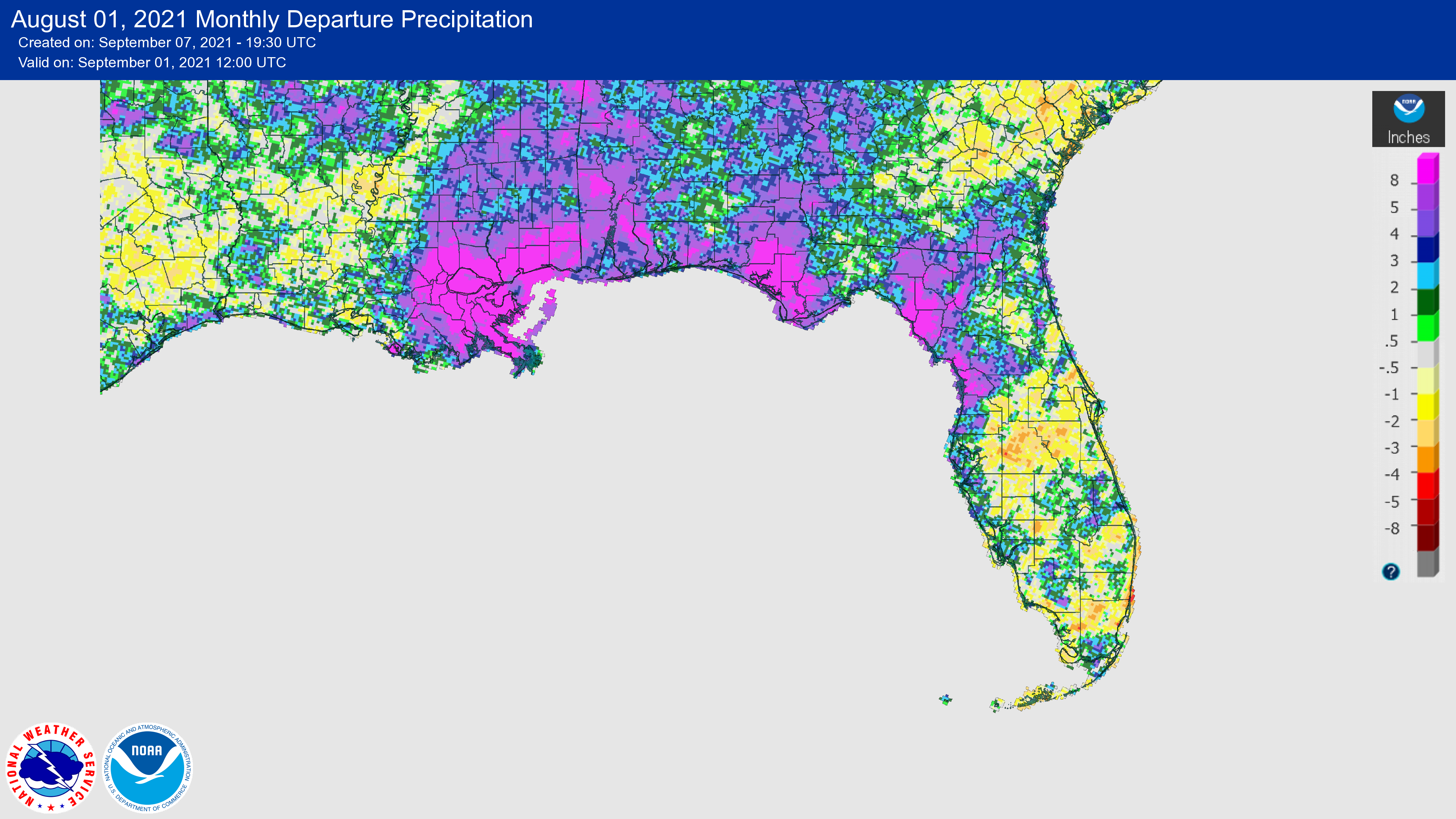
La Niña Watch.
A transition from ENSO-neutral to La Niña is favored in the next couple of months, with a 70-80% chance of La Niña during the Northern Hemisphere winter 2021-22. Over the last month, ENSO-neutral conditions continued with near-to-below average sea surface temperatures persisting in the central and eastern equatorial Pacific. The latest Niño index values ranged from -0.2 °C to -0.3 °C. As of now, forecasters anticipate La Niña to be of weak strength (seasonal average Niño-3.4 index values between -0.5°C to -0.9°C).
Hazardous Weather Events in August.
According to the Local Storm Reports issued by the local National Weather Service offices serving Florida, there were 700 individual local reports of hazardous weather events recorded across the state during the month of June (see Table 4 for a breakdown by event type). There were many reports of strong thunderstorm wind gusts and flooding throughout the month. Tropical Storm Fred impacted much of the Florida Panhandle on August 16 with rain bands and strong wind gusts of more than 50 mph in places. One injury was reported in Bay County when a tree fell on a car. Lightning strikes resulted in several injuries during the month. Two people were hospitalized with injuries after being struck by lightning at Saint Petersburg Beach on the 12th and two more people suffered injuries after being struck by lightning in Clearwater and Safety Harbor on the 13th. A fatality resulted when a kitesurfer was blown off course and launched into a building at Fort Lauderdale Beach due to strong thunderstorms with gusty winds in the area.
Table 4. Breakdown of storm reports submitted in Florida during the month of August (compiled from Iowa State University/Iowa Environmental Mesonet).
| Report Type | Number of Reports |
| Flood | 33 |
| Flash Flood | 39 |
| Hail | 6 |
| Heavy Rain | 26 |
| Marine Thunderstorm Wind | 243 |
| Non-Thunderstorm Wind Gust | 70 |
| Tornado/Waterspout/Funnel Cloud | 3/11/3 |
| Thunderstorm Wind Damage | 27 |
| Thunderstorm Wind Gust | 216 |
| Lightning | 5 |
| Tropical Storm | 18 |
Drought-Related Impacts.
Throughout the month of August, drought did not impact any part of Florida, according to the U.S. Drought Monitor. The past few months have provided sufficient rainfall to prevent abnormally dry or drought conditions from developing.
As of August 31, the Lake Okeechobee water level was at 14.69 ft. above sea level (Feet-NGVD29), which is just above the average for this time of the year. At the first of the month, the water level was 13.72 ft. above sea level.
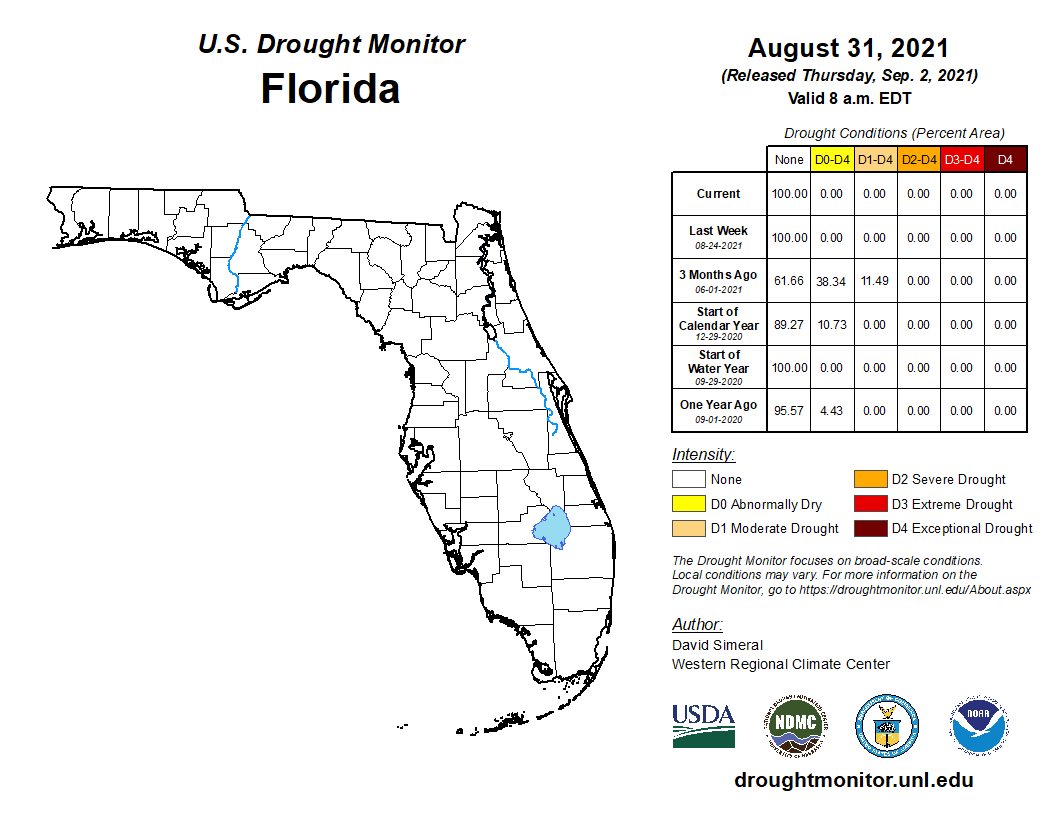
Agriculture-Related Impacts.
During mid-August, topsoil moisture levels were adequate for 68% of the state and short in 3%, while 29% of the state was in surplus. By the end of August, topsoil moisture levels were adequate in 77% of the state and short in 3%, while 20% of the state was in surplus. Much of the state experienced fair (13%), good (54%), or excellent (30%) pasture and range conditions by the end of the month. For more information, consult the weekly Crop Progress and Conditions report published by the USDA's National Agricultural Statistics Service.
Appendix 1
Additional August departures from normal data for select Florida locations (Source: NWS).
| Station | Average Temperature (˚F) | Departure from Normal (˚F) | Total Rainfall (in.) | Departure from Normal (in.) |
| Gainesville | 81.9 | +0.6 | 8.21 | +1.81 |
| Sarasota | 83.4 | 0 | 9.33 | +0.22 |
| Melbourne | 82.9 | -0.5 | 7.08 | +0.41 |
| Fort Myers | 82.7 | +1.3 | 7.75 | -1.00 |
| West Palm Beach | 84.5 | +1.3 | 9.90 | +1.22 |
Appendix 2
Select daily record high maximum temperatures tied or broken during August (compiled from NOAA).
| Location | Date | Record (˚F) | Broken/Tied | Last |
| Key West | 1 | 94 | Broken | 93 in 2020 |
| Miami Beach | 1 | 96 | Broken | 93 in 1999 |
| Quincy | 2 | 99 | Tied | 99 in 2010 |
| Plant City | 6 | 98 | Tied | 98 in 1980 |
| Plant City | 7 | 98 | Broken | 97 in 2020 |
| Key West | 9 | 95 | Broken | 94 in 2020 |
| Crestview | 10 | 97 | Tied | 97 in 2015 |
| Tampa | 12 | 96 | Tied | 96 in 1972 |
| Tampa | 18 | 97 | Broken | 95 in 1960 |
| Clermont | 19 | 99 | Broken | 97 in 2018 |
| Orlando | 19 | 97 | Tied | 97 in 2005 |
| Plant City | 20 | 100 | Broken | 98 in 2017 |
| Punta Gorda | 20 | 97 | Tied | 97 in 2014 |
| Gainesville | 20 | 95 | Tied | 95 in 2016 |
| Clermont | 21 | 98 | Broken | 97 in 2017 |
| Plant City | 21 | 100 | Broken | 99 in 1902 |
| Daytona Beach | 21 | 97 | Broken | 96 in 2016 |
| Clermont | 22 | 98 | Broken | 97 in 2016 |
| Punta Gorda | 22 | 98 | Broken | 97 in 2018 |
| Daytona Beach | 23 | 94 | Broken | 93 in 2015 |
| Punta Gorda | 23 | 98 | Broken | 97 in 2016 |
| Tampa | 25 | 96 | Tied | 96 in 2020 |
Appendix 3
Select daily record high minimum temperatures tied or broken during August (compiled from NOAA).
| Location | Date | Record (˚F) | Broken/Tied | Last |
| Clermont | 1 | 77 | Broken | 75 in 2019 |
| Tarpon Springs | 1 | 82 | Broken | 80 in 1999 |
| Venice | 1 | 83 | Tied | 83 in 2012 |
| Fort Myers | 1 | 80 | Broken | 79 in 1999 |
| Tampa | 1 | 83 | Tied | 83 in 1999 |
| Key West | 1 | 86 | Broken | 84 in 1977 |
| Punta Gorda | 2 | 80 | Broken | 79 in 1999 |
| Venice | 2 | 84 | Broken | 79 in 2012 |
| Fort Myers | 2 | 79 | Broken | 78 in 2012 |
| Key West | 2 | 86 | Broken | 84 in 1962 |
| Lakeland | 2 | 78 | Broken | 76 in 1958 |
| Key West | 5 | 86 | Broken | 84 in 2020 |
| Key West | 7 | 85 | Broken | 84 in 2020 |
| Cross City | 9 | 76 | Broken | 75 in 2019 |
| Key West | 9 | 87 | Broken | 85 in 2020 |
| Lakeland | 11 | 77 | Broken | 76 in 1991 |
| Fort Lauderdale Beach | 12 | 83 | Broken | 82 in 2004 |
| Daytona Beach | 13 | 83 | Broken | 79 in 2013 |
| Fort Pierce | 13 | 82 | Broken | 81 in 1937 |
| West Palm Beach | 15 | 83 | Broken | 81 in 2016 |
| Usher Tower | 16 | 79 | Broken | 76 in 2017 |
| Orlando | 16 | 79 | Broken | 78 in 2010 |
| Daytona Beach | 17 | 79 | Broken | 78 in 2010 |
| Perry | 18 | 77 | Broken | 76 in 2010 |
| Miami | 18 | 83 | Broken | 82 in 2015 |
| Jacksonville Beach | 19 | 81 | Tied | 81 in 2009 |
| Clermont | 20 | 77 | Broken | 76 in 2016 |
| Cross City | 20 | 77 | Broken | 75 in 2010 |
| Tampa | 21 | 81 | Broken | 79 in 2018 |
| Usher Tower | 22 | 79 | Broken | 77 in 2015 |
| Miami | 22 | 82 | Broken | 81 in 2007 |
| Pensacola | 22 | 79 | Broken | 78 in 2017 |
| Quincy | 23 | 75 | Broken | 74 in 1993 |
| Key West | 23 | 86 | Broken | 84 in 2020 |
| Crestview | 23 | 77 | Broken | 75 in 2015 |
| Perry | 24 | 76 | Broken | 75 in 2019 |
| Miami | 24 | 84 | Broken | 82 in 2000 |
| Key West | 24 | 87 | Broken | 84 in 1964 |
| Clermont | 28 | 78 | Broken | 77 in 2020 |
| Perrine | 28 | 81 | Broken | 79 in 2005 |
| Clermont | 28 | 78 | Broken | 77 in 2020 |
| Usher Tower | 28 | 78 | Broken | 76 in 2012 |
| West Palm Beach | 28 | 83 | Broken | 81 in 2010 |
| Key West | 29 | 85 | Broken | 84 in 2014 |
| Crestview | 31 | 76 | Broken | 74 in 2020 |
Prepared by Florida Climate Center
The Florida State University
Tallahassee, FL
February Key Points:
- Warmer weather returned in February, with average temperatures above normal in Florida.
- February was dry for much of Florida, with below normal monthly rainfall totals across the state.
- The La Niña advisory remains in effect and is expected to continue through May 2022 (77% chance).
- As of February 22, about 13% of the state is in moderate drought (D1) and 58% is experiencing abnormally dry conditions (D0), according to the U.S. Drought Monitor.
Average temperatures in February were above normal in Florida. Average temperature departures from normal ranged from +0.2 ̊F in Key West to +3.9 ̊F in Tampa for the month (see Table 1 and Appendix 1 for select cities). Several stations recorded one of their top ten warmest months of February on record, including Jacksonville Beach (5th-warmest), Orlando (7th-warmest), Fort Myers (8th-warmest), and Fort Lauderdale (8th-warmest). Several daily temperature records were tied or broken throughout the month, including daily high maximum and high minimum temperatures (see appendices 2 and 3).
Table 1. February average temperatures and departures from normal ( ̊F) for selected cities.
| Station | Mean Temperature | Departure from Normal |
| Pensacola | 57.4 | +0.6 |
| Tallahassee | 56.3 | +0.7 |
| Jacksonville | 58.8 | +1.3 |
| Orlando | 67.0 | +3.4 |
| Tampa | 68.6 | +3.9 |
| Miami | 73.5 | +2.8 |
| Key West | 72.5 | +0.2 |
Rainfall totals in February were below normal across the state. The monthly precipitation departures from normal ranged from -0.55 inches in Miami to -3.00 inches in Tallahassee (Table 2 and Appendix 1). Most places across the state recorded a precipitation deficit for the month, except for just a few places in south Florida (Figure 1). Crestview had its second driest February on record, and both Ocala and Apalachicola recorded their 4th-driest February on record. Rainfall deficits have resulted in abnormally dry conditions and the emergence of moderate drought conditions in parts of the western Peninsula (drought information below).
Table 2. February precipitation totals and departures from normal (inches) for selected cities.
| Station | Total Rainfall | Departure from Normal |
| Pensacola | 2.78 | -1.99 |
| Tallahassee | 1.28 | -3.00 |
| Jacksonville | 2.09 | -0.77 |
| Orlando | 0.71 | -1.33 |
| Tampa | 0.62 | -2.00 |
| Miami | 1.60 | -0.55 |
| Key West | 1.35 | -0.19 |
Figure 1. A graphical depiction of the monthly rainfall departure from normal (inches) for February (courtesy of NOAA, NWS).
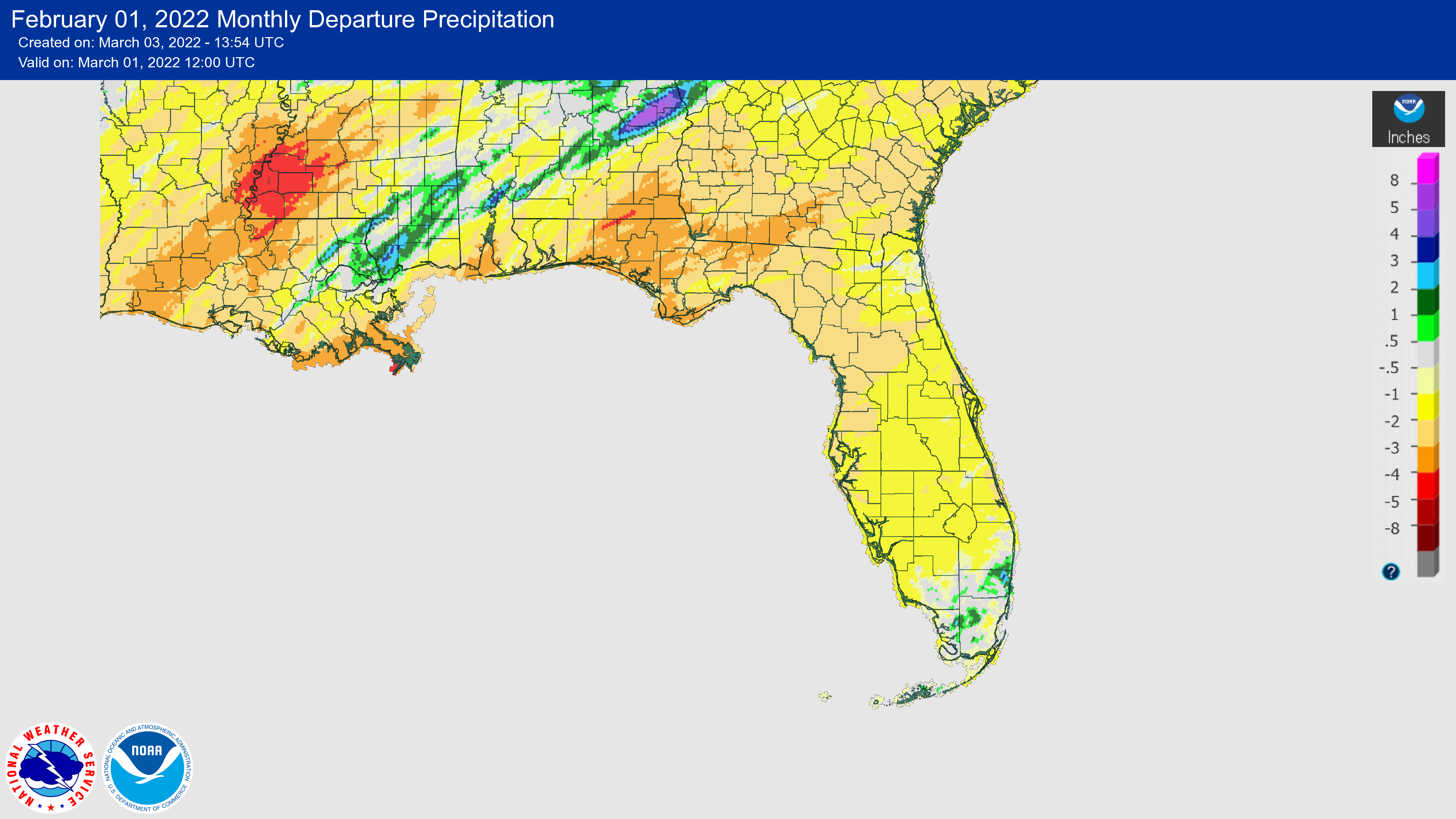
La Niña Advisory Continues.
La Niña conditions, the cool phase of the ENSO climate pattern, continued in the tropical Pacific Ocean in February. Below-average sea surface temperatures weakened during January, but most of the weekly ENSO indices remained between -0.5 ̊ C and -1.0 ̊ C. Overall, the coupled ocean-atmosphere system reflected a weakening La Niña. According to the latest official NWS update, La Niña is likely to continue into the Northern Hemisphere spring, with a 77% chance of persisting through May 2022. It is likely to then transition to ENSO-neutral in late spring or summer (56% chance during May-July 2022).
Hazardous Weather Events in February.
According to the Local Storm Reports issued by the local National Weather Service offices serving Florida, there were 21 individual local reports of hazardous weather events recorded across the state during the month of February 2022 (see Table 4 for a breakdown by event type). Though there were few severe weather events during the month, several fatalities occurred. Strong rip currents at Fort Lauderdale Beach led to two injuries and one fatality on the 7th. Later in the month, dense fog led to three fatalities resulting from two car accidents in Flagler County on the 25th.
Table 4. Breakdown of storm reports submitted in Florida during the month of February (compiled from Iowa State University/Iowa Environmental Mesonet).
| Report Type | Number of Reports |
| Flash Flood | 0 |
| Heavy Rain | 0 |
| Dense Fog | 1 |
| Marine Thunderstorm Wind | 3 |
| Non-Thunderstorm Wind Gust | 10 |
| Non-Thunderstorm Wind Damage | 0 |
| Tornado/Waterspout/Funnel Cloud | 0/1/0 |
| Thunderstorm Wind Damage | 0 |
| Thunderstorm Wind Gust | 4 |
| Rip Currents | 2 |
Drought-Related Impacts.
By mid-February, abnormally dry conditions (D0) were affecting 53% of the state, according to the U.S. Drought Monitor. Affected areas included the central and western Panhandle and Big Bend regions, as well as much of northern and western Florida. This was an increase from 17% of the state in abnormally dry conditions and 1.4% of the western Panhandle in moderate drought at the beginning of the month. Near the end of the month, moderate drought (D1) emerged across the north-west portions of the Peninsula and re-emerged in the extreme western Panhandle (13% area total), while 58% of the state was abnormally dry (Figure 2).
As of February 28, the Lake Okeechobee water level was 14.58 ft. above sea level (Feet-NGVD29), which is about average for this time of the year. The water level remained above average but declined throughout the month. At the first of the month, the water level was around 14.91 ft. above sea level.
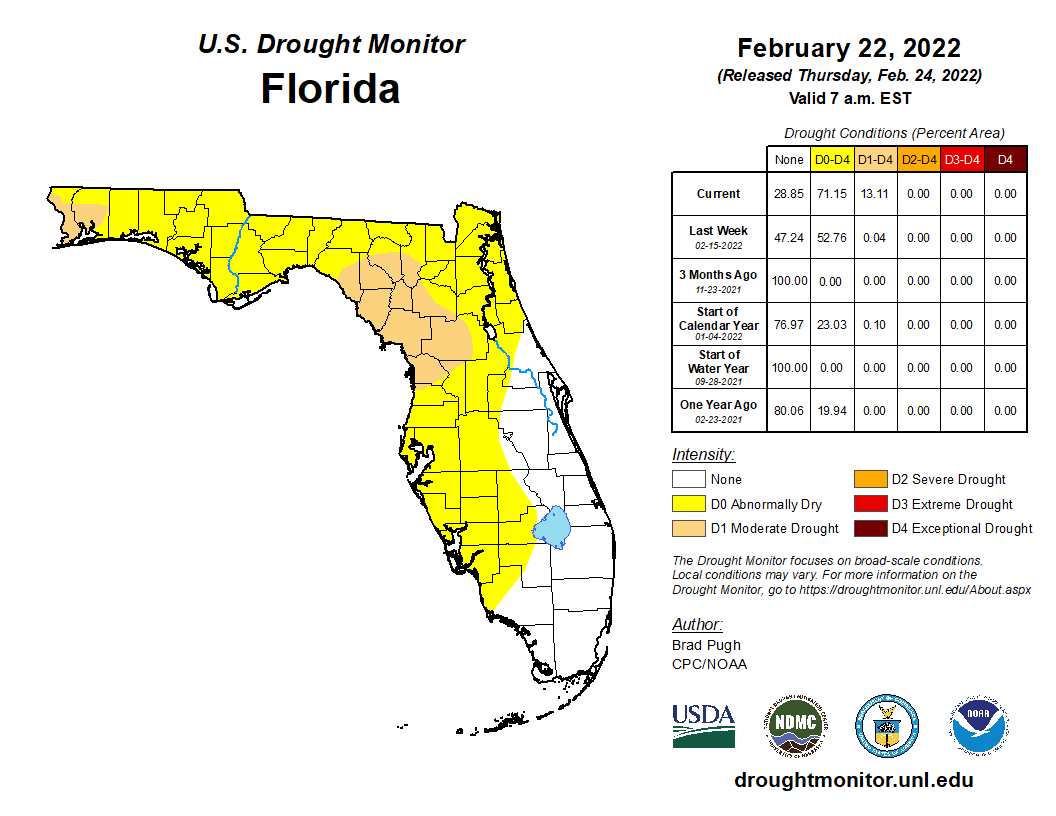
Agriculture-Related Impacts.
During the month of February, damage to crops and pasture were seen early in the month due to frosts. Pasture conditions were degraded to mostly poor and fair conditions. However, cattle remained in mostly good condition due to supplemental feedings. Sugarcane crop exhibited signs of leaf burn. Strawberry harvest continued, and several citrus and vegetable crops were marketed including white and red grapefruit, tangerines, tomatoes, peppers, eggplant, sweet corn, green beans, avocadoes, and others. For more information, consult the Crop Progress - State Stories reports, which are produced monthly December through March.
Appendix 1
Additional February departures from normal data for select Florida locations (Source: NWS).
| Station | Average Temperature (˚F) | Departure from Normal (˚F) | Total Rainfall (in.) | Departure from Normal (in.) |
| Gainesville | 60.3 | +1.9 | 1.56 | -1.11 |
| Sarasota | 66.4 | +1.6 | 0.71 | -1.21 |
| Melbourne | 66.2 | +0.8 | 0.79 | -1.19 |
| Fort Myers | 71.1 | +3.8 | 0.48 | -1.30 |
| West Palm Beach | 72.1 | +3.7 | 1.97 | -0.66 |
Appendix 2
Select daily record high maximum temperatures broken or tied during February (compiled from NOAA).
| Location | Date | Record (˚F) | Broken/Tied | Last |
| Tampa | 3 | 85 | Broken | 84 in 2016 |
| Gainesville | 4 | 83 | Broken | 82 in 2014 |
| Orlando | 4 | 87 | Broken | 86 in 2014 |
| Key West | 4 | 85 | Broken | 83 in 2020 |
| Lakeland | 4 | 86 | Broken | 85 in 1989 |
| Clermont | 5 | 87 | Broken | 86 in 2014 |
| Jacksonville Beach | 5 | 82 | Broken | 80 in 1997 |
| Key West | 8 | 86 | Broken | 83 in 2014 |
| Tampa | 16 | 84 | Tied | 84 in 1989 |
| Tarpon Springs | 17 | 85 | Tied | 85 in 2019 |
| Tampa | 17 | 86 | Broken | 83 in 1995 |
| Clermont | 18 | 88 | Tied | 88 in 2019 |
| Perry | 18 | 83 | Broken | 82 in 1995 |
| Orlando | 18 | 87 | Tied | 87 in 2021 |
| Tarpon Springs | 22 | 87 | Broken | 86 in 1997 |
| Key West | 22 | 86 | Broken | 85 in 2019 |
| Fort Myers | 23 | 89 | Tied | 89 in 1962 |
| Tallahassee | 23 | 83 | Tied | 83 in 2019 |
| Tampa | 24 | 86 | Broken | 85 in 2001 |
| Key West | 24 | 88 | Broken | 86 in 2019 |
| Jacksonville Beach | 25 | 87 | Broken | 82 in 2017 |
| Miles City | 25 | 88 | Tied | 88 in 2018 |
| Gainesville | 25 | 87 | Broken | 85 in 2018 |
| Daytona Beach | 25 | 87 | Broken | 86 in 2001 |
| Fort Myers | 26 | 89 | Broken | 87 in 1971 |
Appendix 3
Select daily record high minimum temperatures broken or tied during February (compiled from NOAA).
| Location | Date | Record (˚F) | Broken/Tied | Last |
| Jacksonville Beach | 4 | 68 | Broken | 64 in 1990 |
| Quincy | 4 | 64 | Broken | 61 in 2014 |
| Wewahitchka | 4 | 65 | Broken | 64 in 1990 |
| Key West | 4 | 77 | Broken | 76 in 2014 |
| Fort Pierce | 17 | 69 | Tied | 69 in 1981 |
| Stuart | 17 | 70 | Tied | 70 in 1984 |
| Miami | 17 | 72 | Tied | 72 in 2021 |
| Key West | 17 | 76 | Tied | 76 in 1975 |
| Daytona Beach | 18 | 67 | Broken | 66 in 2019 |
| Mayport | 18 | 63 | Broken | 62 in 2019 |
| Orlando | 18 | 68 | Broken | 65 in 2021 |
| Daytona Beach | 18 | 69 | Broken | 66 in 1990 |
| Orlando | 18 | 70 | Broken | 67 in 2019 |
| Jacksonville | 18 | 66 | Broken | 65 in 2019 |
| Clermont | 19 | 70 | Broken | 66 in 1992 |
| Sanford | 19 | 68 | Broken | 65 in 2012 |
| Fort Pierce | 23 | 71 | Tied | 71 in 2018 |
| Jacksonville Beach | 23 | 68 | Broken | 66 in 2013 |
| Tampa | 23 | 70 | Broken | 69 in 2019 |
| Jacksonville Beach | 24 | 69 | Broken | 67 in 2012 |
| Pensacola | 24 | 65 | Broken | 64 in 1949 |
| Jacksonville Beach | 25 | 70 | Broken | 62 in 2011 |
| Jacksonville Beach | 26 | 67 | Broken | 64 in 1992 |
| Fort Lauderdale Beach | 27 | 72 | Tied | 72 in 2013 |
| Jacksonville Beach | 27 | 68 | Broken | 64 in 1971 |
Prepared by Florida Climate Center
The Florida State University
Tallahassee, FL
Average temperature departures in September were near normal across the state. Average temperature departures ranged from -1.3 ̊F in Key West to +1.7 ̊F in Orlando for the month (see Table 1 and Appendix 1 for select cities). Several daily high maximum temperature records set (see Appendix 2) and a few daily high minimum records during the month.
Table 1. September average temperatures and departures from normal ( ̊F) for selected cities.
| Station | Mean Temperature | Departure from Normal |
| Pensacola | 78.9 | -1.1 |
| Tallahassee | 78.4 | -0.7 |
| Jacksonville | 77.9 | -0.9 |
| Orlando | 82.7 | +1.7 |
| Tampa | 83.1 | +0.4 |
| Miami | 83.1 | +0.1 |
| Key West | 83.7 | -1.3 |
Rainfall totals in September were mixed, as many areas received well above normal rainfall while some areas had below normal rainfall (Figure 1). Monthly departures from normal ranged from +4.66 inches in Pensacola to -4.71 inches in Key West (Table 2 and Appendix 1). The western Panhandle region continues to be wetter than normal, with a surplus in annual rainfall at Pensacola nearly 20 inches above normal for the year.
Table 2. September precipitation totals and departures from normal (inches) for selected cities.
| Station | Total Rainfall | Departure from Normal |
| Pensacola | 11.27 | +4.66 |
| Tallahassee | 8.26 | +3.35 |
| Jacksonville | 5.11 | -2.45 |
| Orlando | 5.65 | -0.72 |
| Tampa | 7.39 | +1.30 |
| Miami | 12.12 | +1.90 |
| Key West | 2.53 | -4.71 |
Figure 1. A graphical depiction of the monthly rainfall departure from normal (inches) for September (courtesy of NOAA, NWS).
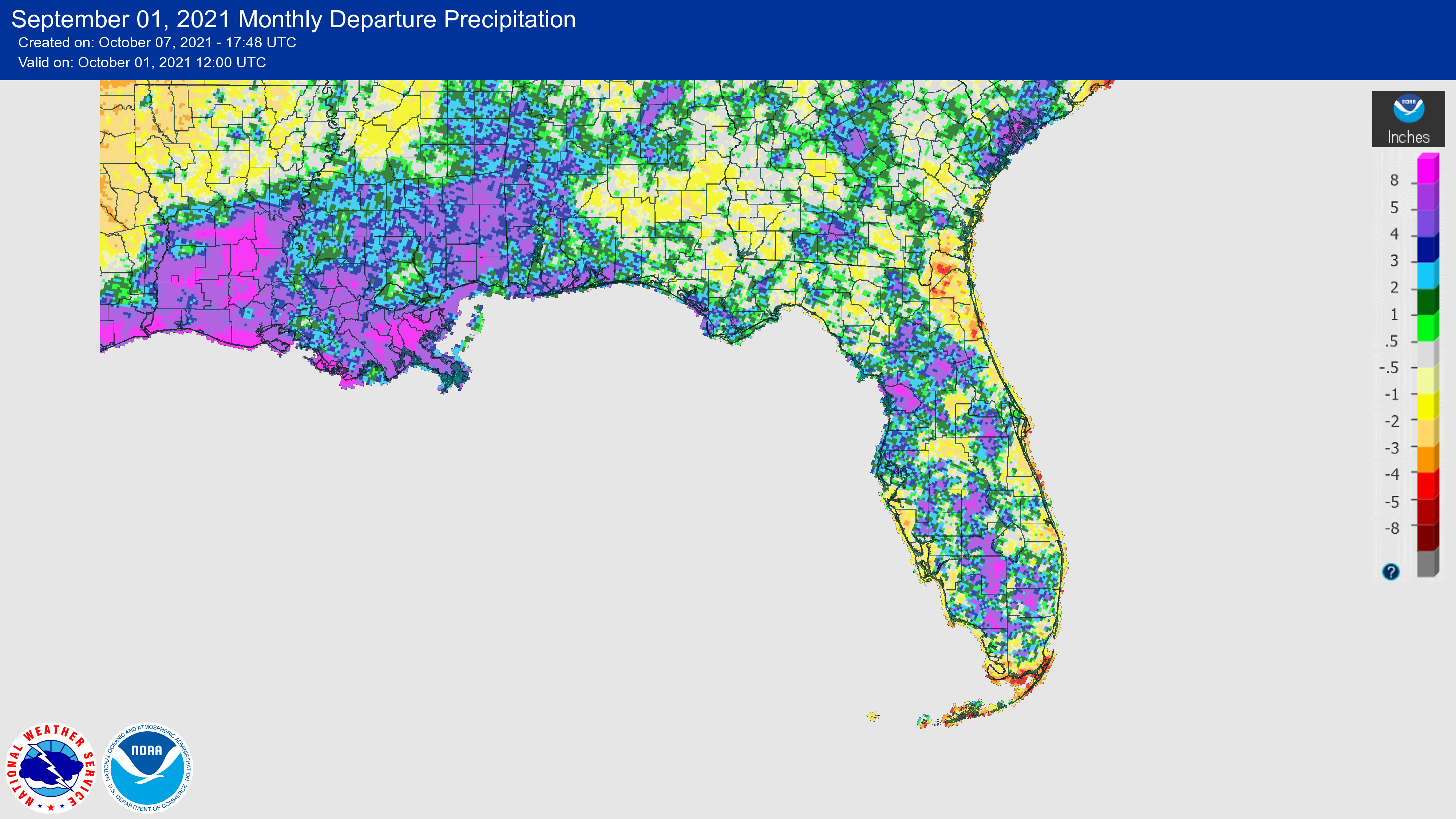
La Niña Watch.
The central tropical Pacific Ocean is in a neutral state, but a transition from ENSO-neutral to La Niña is favored this fall, with a 70-80% chance of La Niña emerging during the Northern Hemisphere winter 2021-22. Over the last month, ENSO-neutral conditions continued with near-to-below average sea surface temperatures persisting in the central and eastern equatorial Pacific. The latest Niño index values ranged from -0.2 °C to -0.3 °C. As of now, forecasters anticipate La Niña to be of weak strength (seasonal average Niño-3.4 index values between -0.5°C to -0.9°C).
Hazardous Weather Events in September.
According to the Local Storm Reports issued by the local National Weather Service offices serving Florida, there were 225 individual local reports of hazardous weather events recorded across the state during the month of September (see Table 4 for a breakdown by event type). Tropical Storm Mindy made landfall in the Florida Panhandle on September 9th at St. Vincent Island with maximum sustained winds of 45 mph. The system produced wind gusts of up to 61 mph and daily rainfall exceeding 4 inches in parts of Tallahassee and the surrounding area. Heavy rainfall affected several areas throughout the month, including an estimated 4.22 inches that fell in one hour at the Sanford Airport in Seminole County on the 20th. There were several reports of fatalities from rip currents during the month, as well as one fatality due to lightning in Manatee County.
Table 4. Breakdown of storm reports submitted in Florida during the month of September (compiled from Iowa State University/Iowa Environmental Mesonet).
| Report Type | Number of Reports |
| Flood | 33 |
| Flash Flood | 6 |
| Hail | 2 |
| Heavy Rain | 56 |
| Marine Hail | 1 |
| Marine Thunderstorm Wind | 26 |
| Non-Thunderstorm Wind Gust | 2 |
| Tornado/Waterspout/Funnel Cloud | 1/17/1 |
| Thunderstorm Wind Damage | 6 |
| Thunderstorm Wind Gust | 31 |
| Lightning | 2 |
| Tropical Storm | 37 |
| Rip Currents | 4 |
Drought-Related Impacts.
The month of September remained drought free across the state. No areas were impacted by drought, according to the U.S. Drought Monitor.
As of September 30, the Lake Okeechobee water level was at 15.55 ft. above sea level (Feet-NGVD29), which is above the average for this time of the year. The water level remained above average throughout the month. At the first of the month, the water level was 14.69 ft. above sea level.
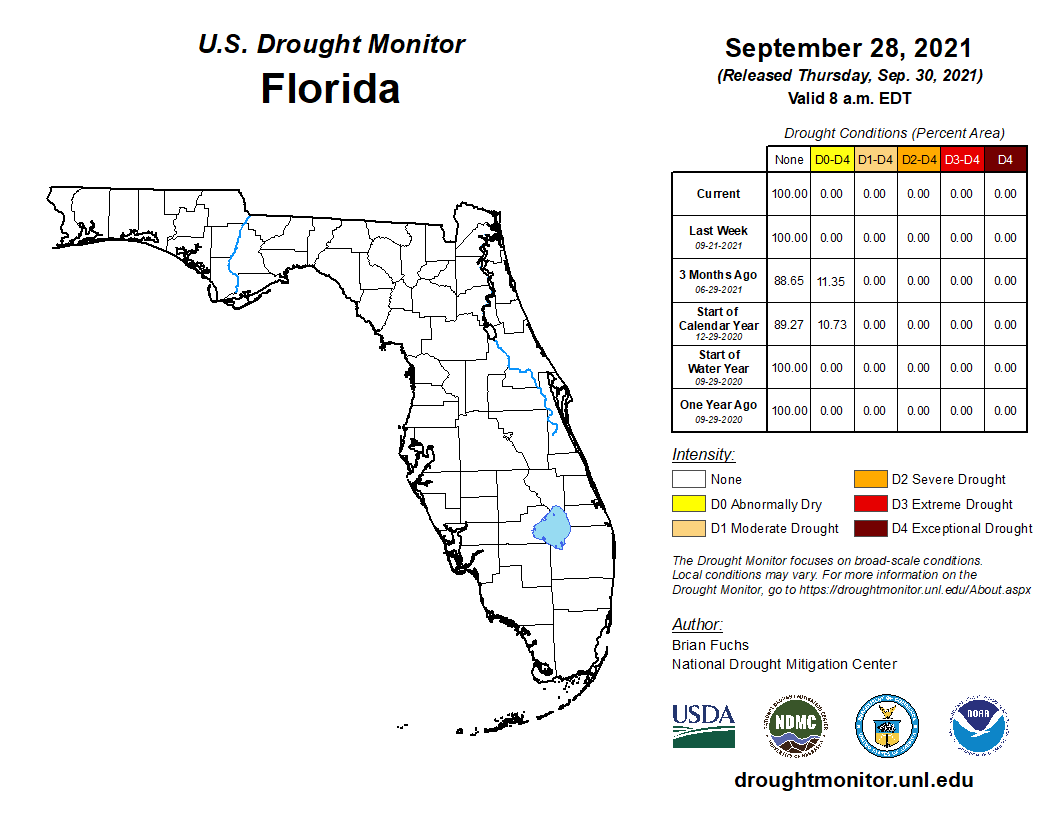
Agriculture-Related Impacts.
During mid-September, topsoil moisture levels were adequate for 70% of the state, short in 4%, and 26% of the state was in surplus. By the end of September, topsoil moisture levels were adequate in 67% of the state, short in 5%, and 28% of the state was in surplus. Much of the state had either fair (20%), good (52%) or excellent (24%) pasture and range conditions by the end of the month. For more information, consult the weekly Crop Progress and Conditions report published by the USDA's National Agricultural Statistics Service.
Appendix 1
Additional September departures from normal data for select Florida locations (Source: NWS).
| Station | Average Temperature (˚F) | Departure from Normal (˚F) | Total Rainfall (in.) | Departure from Normal (in.) |
| Gainesville | 78.5 | -0.3 | 8.67 | +3.62 |
| Sarasota | 81.8 | -0.4 | 5.30 | -0.70 |
| Melbourne | 80.9 | -1.2 | 3.53 | -4.10 |
| Fort Myers | 83.3 | +1.1 | 9.03 | +0.03 |
| West Palm Beach | 82.4 | +0.5 | 6.64 | -1.32 |
Appendix 2
Select daily record high maximum temperatures tied or broken during September (compiled from NOAA).
| Location | Date | Record (˚F) | Broken/Tied | Last |
| Jacksonville Beach | 1 | 95 | Broken | 93 in 2007 |
| Miami | 1 | 96 | Broken | 95 in 2006 |
| Vero Beach | 1 | 95 | Broken | 94 in 2017 |
| Perrine | 2 | 95 | Broken | 94 in 1996 |
| Miami | 5 | 94 | Broken | 93 in 2020 |
| Orlando | 6 | 95 | Tied | 95 in 2019 |
| Punta Gorda | 7 | 95 | Tied | 95 in 2019 |
| Plant City | 8 | 97 | Tied | 97 in 1937 |
| Key West | 8 | 93 | Tied | 93 in 2020 |
| Vero Beach | 9 | 96 | Broken | 95 in 1987 |
| West Palm Beach | 9 | 94 | Tied | 94 in 1993 |
| Key West | 10 | 93 | Broken | 92 in 2015 |
| Punta Gorda | 12 | 96 | Tied | 96 in 2019 |
| Tampa | 12 | 95 | Broken | 94 in 2019 |
| Fort Myers | 12 | 94 | Tied | 94 in 2011 |
| Key West | 12 | 93 | Tied | 93 in 2007 |
| Tampa | 13 | 95 | Tied | 95 in 1990 |
| Plant City | 14 | 95 | Tied | 95 in 2018 |
| Key West | 24 | 91 | Tied | 91 in 2020 |
| Fort Myers | 26 | 95 | Tied | 95 in 1988 |
| Key West | 28 | 92 | Tied | 92 in 2020 |


